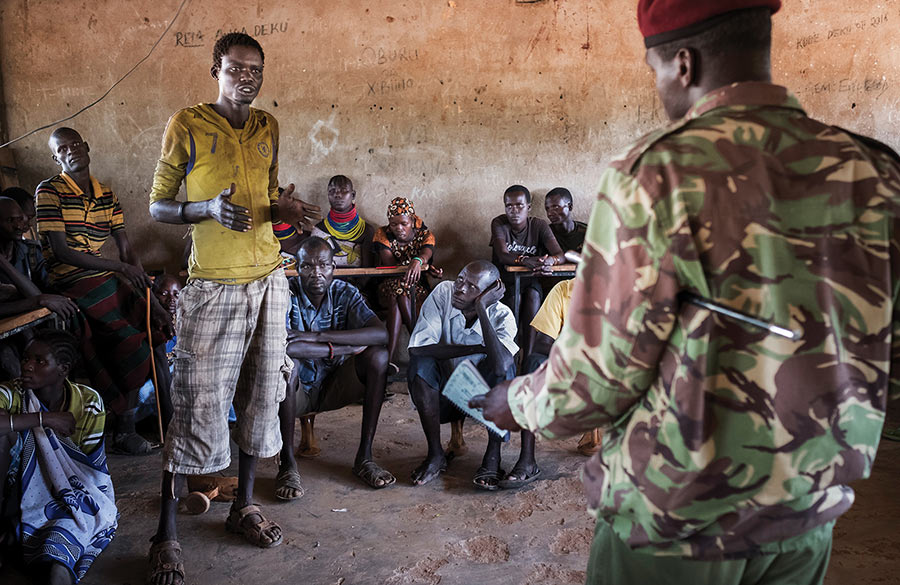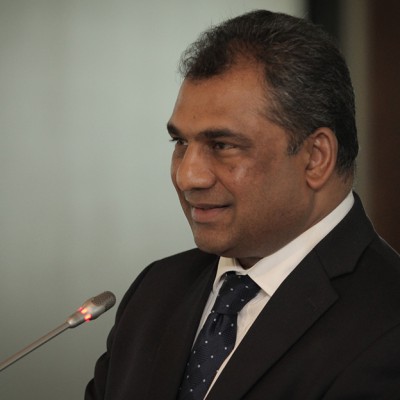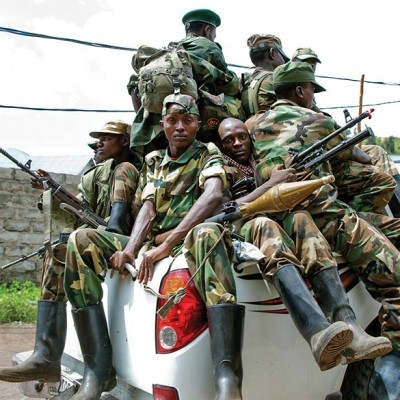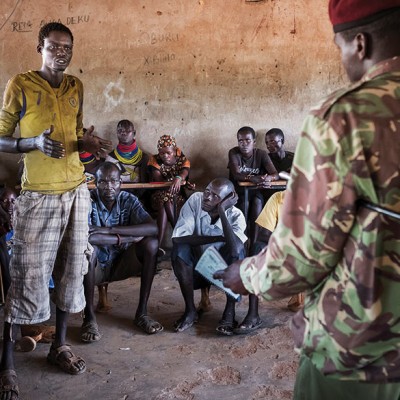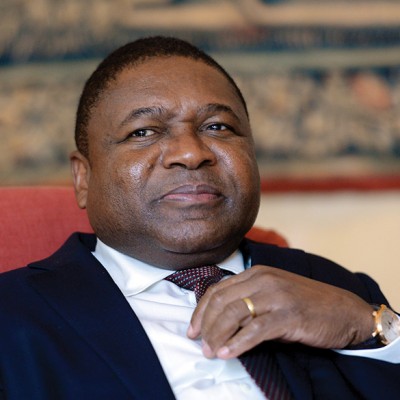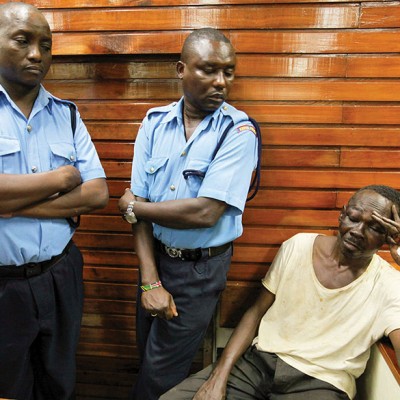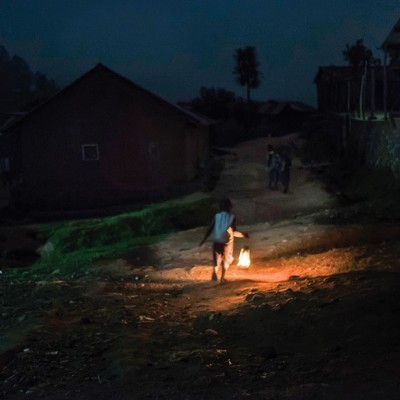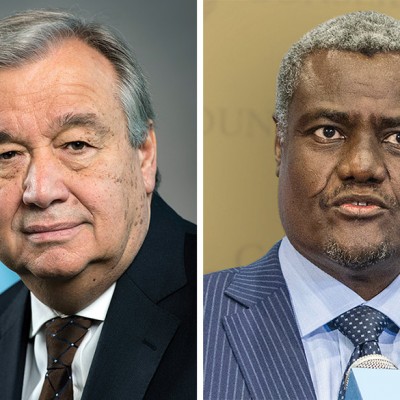Introduction
Borders and borderlands in Africa are spaces where the nexus of security, development, crime, conflict and politics is often at its most dynamic. In theory, borders serve to demarcate states’ territory, and the movement of goods and people across them are managed in the interests of national trade and security. In practice, African borders are often little more than notional lines across huge stretches of land or water. This article examines the increasing prominence of border security in policy discussions and introduces the “people-centred” approach to border management expounded by the Danish Demining Group (DDG). DDG has worked in cross-border contexts in both East Africa and West Africa and the article compares its impact in each location, highlighting the community-first ethos of the organisation’s programming. Drawing on the lessons learned from both regions, the article concludes with reflections on the strengths, successes and areas for improvement and expansion in people-centred border security and management.
Borders and Borderlands in Africa: The Security Context
A crucial feature of borderlands in Africa is the difference in how they are perceived by local people and the central government. For locals, the border or borders they live on or near are frequently hypothetical, without physical markers or regulatory presence. Pastoralist groups cross back and forth seeking – and sometimes fighting over – water and grazing lands for their herds; individuals cross to see family members, buy goods or access services; for businesspeople, borders present economic opportunities in trade routes, goods and markets. For central governments, on the other hand, borderlands are often viewed as places where their control over citizens is weak, illegal trade occurs and security threats from insurgent groups can enter their territory. Accordingly, national border management policy tends to have a default aim of “hardening” borders: the building of “symbolic, legal, and material walls, fences, and frontiers”.1
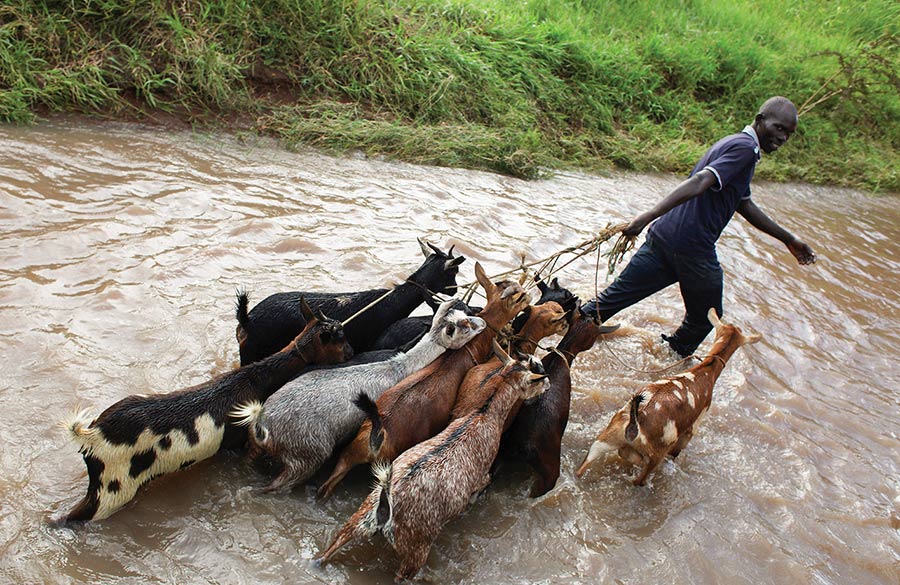
In many cases, however, especially between fragile or conflict-affected states, a lack of resources, capacity and/or will causes border management by the government to be weak and intermittent. What limited systems exist tend to concentrate on border posts rather than along whole border lines. State border security personnel are frequently undertrained and under-equipped for the level of challenges they encounter and, due to the remote nature of many of the locations in which they operate, face low levels of accountability for their actions. In combination, these factors can lead to the relationship between security providers and the communities they work within being one of resentment and suspicion, adding to, rather than mitigating, insecurity. In sum, borderlands in Africa are typically characterised by low state presence, mistrust between local communities and the state, and high levels of crime, insecurity and poverty.
This context is currently rising from national to global significance for three primary reasons. First, at present globally there is a high level of concern with international migration. People from Africa are a significant portion of those attempting to reach Europe in the so-called “refugee crisis” that began in 2014: interest is therefore developing, especially in European countries, around the part borders in Africa play in the movement of people.2 Second, borders are crucial components in terrorism and security dynamics with regard to insurgent movements; trafficking of arms, drugs and people; and smuggling. Extremist groups such as al-Shabaab, Boko Haram and al-Qaeda in the Islamic Maghreb have a global profile; while they may or may not target border areas as such, low state presence, a lack of interstate cooperation and frequent marginalisation of cross-border ethnic groups do comprise environments where their operational capacity can strengthen. Third, especially in East African countries, recent discoveries of highly valuable natural resources, including oil, have caused the incentives for national governments to demarcate and police the outlying areas of their territory to spike. In addition, the development of large-scale cross-border infrastructure has become essential, often in territories that historically have received very little governmental attention. Examples of this include the Moyale area in the centre of the Kenya-Ethiopia border, and the Karamoja region that joins Kenya, South Sudan and Uganda. In the former example, a major new highway between Isiolo and Addis Ababa is the most evident sign of a 2015 bilateral agreement to boost economic growth and pacify the region’s endemic livestock raids and political violence.3 In the latter example, the discovery of oil reserves in north-eastern Kenya and northern Uganda has drastic implications for national economic development plans, impacting projects such as the Lamu-South Sudan-Ethiopia Transport (LAPSSET) Corridor, a multi-billion dollar regional infrastructure investment.4 The development and security implications of these dynamics by definition have international repercussions.

DDG’s approach to Border Security and Management
DDG is a specialised unit within the Danish Refugee Council, working in humanitarian mine action and armed violence reduction. Its mission is to create safe environments where people can live free from armed violence and the remnants of conflict. DDG has delivered cross-border programmes in both East Africa and West Africa. Its approach to border security and management is distinctive in that it focuses on the security needs of local communities in borderland areas. As opposed to top-down, nationally oriented methods of policymaking, this people-centred stance works primarily to strengthen the capacity of borderland communities and their existing security providers to offer their own solutions to insecurity.
Three locations where DDG works that sustain protracted cross-border conflict are the northern Uganda-Kenya border; the meeting point of Ethiopia, Kenya and Somalia, known as the Mandera Triangle; and the Liptako Gourma region of the Sahel, the borderlands between Burkina Faso, Mali and Niger. The northern stretch of Uganda’s border with Kenya suffers from conflict driven by a culture of livestock raiding, low levels of law enforcement, a proliferation of small arms and light weapons, and the illegal trade of various goods.5 Insecurity in the Mandera Triangle stems mainly from insurgent and terrorist activities by al-Shabaab, but there are also high levels of politically motivated ethnic conflict and violent competition among pastoral groups for resources.6 Liptako Gourma, meanwhile, is the site of armed disputes over sparse natural resources, banditry, various forms of trafficking and activities of extremist groups.7

West Africa
DDG works in 14 communities in the Liptako Gourma region, six in Burkina Faso, six in Mali and two in Niger. The focus of activities is on supporting an effective cross-border management system; strengthening the capacity of border authorities; improving communication and confidence between communities, security providers and local authorities; and providing youth with alternatives to crime and armed violence. These objectives were identified through a detailed needs assessment conducted by DDG field staff over two months in 2014.8 Border communities, security providers, local government and national government representatives were all consulted to establish a comprehensive view of the security context.
DDG has helped 13 of the 14 communities develop and implement safety plans through training or the provision of material. Communities have received conflict management education and risk education on small arms, landmines and explosives. Since the beginning of 2016, the programme has added livelihood activities, working specifically with women and youth associations. These activities contribute to income generation, reactivating markets and commercial activities in border areas, and meeting the needs expressed in the community safety plans. For security providers – the police, gendarmerie, customs officials and, in some cases, garde nationale and armed forces – training has been held in conflict analysis, conflict management and conflict prevention. To boost the practical capacity of border management, DDG provided equipment such as computers, printers and mobile phones to security providers, with the aim of supporting a communication network between security providers, authorities and community leaders. An activity to bridge the work with communities and security providers is the facilitation of dialogue between the two: 13 dialogue workshops and 47 fora have been held across 13 of the 14 communities where DDG is present.
In 2017, the programme is entering the cross-border phase, seeking to build on processes undertaken on each side of the border and initial cross-border meetings between authorities, in line with proposals from the community safety plans and dialogues. Where activities have previously been conducted in each country, the objective now is to establish cross-border community safety plans, cross-border dialogues between security providers and communities, and cross-border cooperation between security providers. These activities will be underpinned by tripartite meetings between authorities to evaluate programme achievements so far. A further step will be to strengthen conflict resolution mechanisms in the communities based on “third party neutral” (TPN) training, and to move from individual conflict management capacities towards the mediation of intercommunity and intracommunity conflicts by key actors in the community.
East Africa
Between October 2015 and March 2016, DDG delivered a pilot project called “Borderlands Conflict Prevention and Management in the Mandera Triangle and Karamoja Cluster” on the Kenya-Somalia and Kenya-Uganda borders. The overall focus of the pilot project was to create stronger relations between communities, security providers and local and national officials to strengthen security capacity. To achieve this, DDG took five foundational steps. First was a stakeholder mapping exercise to ascertain who should be included in the activities, resulting in a broad field – from youth and women’s groups at community level through to national government offices. Second was the crucial step of consulting each stakeholder group to elicit their experiences of cross-border security and efforts to improve it. The information gathered during these consultations guided the remainder of DDG’s project. The third step was to use geographic information system mapping to capture and display visually the outputs from the stakeholder consultations, current conflict dynamics and trends, and past and present peace initiatives. These maps provided a valuable conflict analysis tool for security providers, communities and humanitarian actors alike. In addition, they formed the basis for multi-stakeholder dialogues about key challenges at local and national level.
The two remaining steps were the most substantive. Fourth, DDG conducted capacity-building activities with local stakeholders. These activities included conflict management education for community members; advanced conflict management and conflict sensitivity training for security providers, administrators and community chiefs; and TPN mediation training for a range of government officials, civil society peace actors and security providers. On the Kenya-Uganda border, local drama groups gave performances on small arms sensitisation to nearly 8 000 people. There and on the Kenyan side of the Kenya-Somalia border, a total of 45 local government officials and community leaders attended two-day workshops on alternatives to forced disarmament. In both locations, security providers, local authorities and community leaders were trained in community engagement, people-centred border management and differences in cultures and administrative systems.

The fifth and final step DDG took in this project was to facilitate two categories of dialogue: one between communities and security providers, and the other between high-level actors – politicians, administrators, senior security providers and civil society leaders. Dialogues between local communities and security providers were designed to build trust and understanding between the two, which typically was at a very low level. The rationale for this intervention is that low trust between the two groups is both a driver of conflict in itself and a brake on responses to conflict caused by other factors. Transparency and the explanation of priorities and behaviour were encouraged as a way of tackling the fear and antagonism that frequently characterised the relationship between the two groups. In the high-level dialogue meetings, topics addressed included improving cooperation in cross-border management, strengthening the security sector, supporting the voluntary disarmament of civilians, promoting cross-border trade and livelihoods, and preventing and reintegrating youth from violent radicalisation.
Impact and Future of People-centred Border Management
In Liptako Gourma, a wealth of knowledge on security needs and capacities in borderlands has been made available through community safety plans, evaluation of activities, and regular contact with security providers. This type of knowledge should form the basis of advocacy, directly or indirectly, for national and regional policies to include community-based solutions and opportunities in border areas. In the meantime, community and security provider feedback on the dialogue fora is very positive, and there are indications that relations – and security – have improved. Dialogues have effectively brought stakeholders together to identify and discuss cross-border issues, and could grow in impact by producing concrete policies and initiatives to reduce, prevent and mitigate insecurity.
In East Africa, conflict management, conflict sensitivity and TPN trainings were highly appreciated by recipients. Even in Mandera – the largest town on Kenya’s border with Somalia and a place where al-Shabaab explicitly targets police and army personnel – security providers were eager to attend.9 The demand for such training far outstrips current supply. In Kenya, DDG’s programme revealed both the opportunity and risks presented by the main security provider, the National Police Reserves (NPR). The NPR is formed of local community members – untrained and unpaid, but armed and legitimised by the state. These volunteers are therefore both a potential liability and a potential best solution with regard to community security issues. Their training, command-and-control structure and deployment all have significant scope for improvement, and represents an opportunity for national- and local-level interests around border security to converge. Another such opportunity is in cultural awareness training for state security providers, which is currently insufficient.
Dialogues between communities and security providers are economical and highly effective in building trust, understanding and cooperation. DDG learned that the dialogue format was independently replicated by warrior groups on either side of the Kenya-Uganda border, demonstrating the potential and appeal of the initiative. High-level meetings were found to be very effective at bringing decision-makers together and creating consensus around security issues. As in West Africa, their impact could be maximised by improving their capacity to implement the policies they agree on. The exclusion of traditional leaders – such as village elders – from contemporary security management was also revealed to be a noteworthy factor that could be positively addressed to help reduce tensions between communities.
Conclusion
The lessons drawn from the case studies in this article contribute to a growing appreciation of what must happen to achieve effective cross-border security management. Each stakeholder – from local communities to regional government bodies – has a role to play in the ongoing work to improve security in borderlands.
Regional and national governments have a responsibility to invest in cross-border infrastructure and institutions. Border posts should be built and staffed with customs, security and immigration officials trained in border management, cultural sensitivity and data collection. In addition, countries should conduct joint patrols along border lines. Local governments, meanwhile, are best placed to balance the needs of borderlands communities with national interests. In practice, this means providing and supporting cross-border access to goods and services, creating investment and employment opportunities in border regions, and advocating for the interests of cross-border communities at the national and regional levels. Crucially, local government must also exercise strict control and accountability over security providers.
Non-governmental and civil society organisations have roles to play in training and educating security providers and local communities alike on topics from arms control to migration. They should concentrate on developing borderlands through building local capacity in communications, access to goods and services, livelihoods and advocacy for human rights. These organisations should ensure they are supporting local security, livelihoods and advocacy mechanisms rather than imposing external ones; their research and monitoring capabilities are useful in this regard. Borderlands communities themselves, meanwhile, have responsibilities as well as rights in ensuring their security and prosperity. They must ensure that their definitions of needs are inclusive of all parts of the community, especially those who may have less of a voice, such as women or young people. Community leaders must take the lead in building positive relations with neighbouring communities and security providers alike, and provide support to civil society organisations and initiatives.
These recommendations for people-centred border management are underpinned by a fundamental principle – shared by a growing number of actors, including the African Union Border Programme – that policy agendas for border areas must coincide with the interests of the people who live there.10 Secure and open borders that aid, rather than hinder, the people who live on and around them, are the best and indeed only option for long-term security and development at national and regional level. For this to be achieved, the voices, needs, capacities and initiatives of local borderlands communities must be central to border policy across Africa.
Endnotes
- Weber, Annette (2012) Boundaries with Issues: Soft Border Management as a Solution? Bonn: Friedrich Ebert Stiftung, p. 1.
- Horwood, Christopher and Reitano, Tuesday (2016) A Perfect Storm? Forces Shaping Modern Migration and Displacement. Nairobi: Regional Mixed Migration Secretariat, p. 1.
- UNDP (2015) ‘Ethiopia and Kenya Join Hands on Cross-border Initiative to Boost Sub-regional Peace and Development’, Available at: <http://www.undp.org/content/undp/en/home/presscenter/pressreleases/2015/12/07/ethiopia-and-kenya-join-hands-on-cross-border-initiative-to-boost-sub-regional-peace-and-development.html> [Accessed 23 February 2017].
- For more information, visit <http://www.lapsset.go.ke/>.
- Wepundi, Manasseh and Lynge, Karina (2014) Evolving Traditional Practices: Managing Small Arms in the Horn of Africa and Karamoja Cluster. Geneva: Small Arms Survey.
- Menkhaus, Ken (2014) Conflict Assessment: Northern Kenya and Somaliland. Nairobi: Danish Demining Group, p. 93; and Menkhaus, Ken (2015) Somalia Borderlands Conflict Mapping/Analysis. Nairobi: Danish Demining Group, p. 34.
- Lamptey, Afua (2015) ‘Patrolling a Mirage: The Challenges of Border Security Management in the Sahel’, Available at: <http://www.thebrokeronline.eu/Blogs/Sahel-Watch-a-living-analysis-of-the-conflict-in-Mali/Patrolling-a-mirage-the-challenges-of-border-security-management-in-the-Sahel > [Accessed 3 January 2017].
- Danish Demining Group (2014) ‘Border Security Needs Assessment’, Available at: <http://danishdemininggroup.dk/danish-demining-group/publications-and-videos/reports-articles-evaluations-manuals> [Accessed 3 January 2017].
- Harris, Simon (2016) Borderlands Conflict Prevention and Management in the Mandera Triangle and Karamoja Cluster: Lessons Learned Report. Nairobi: Danish Demining Group, p. 10. DDG undertook extra security precautions in delivering training to security forces in Mandera, but recognises that security threats may necessitate a change in methodology in this or other high-risk contexts in future.
- African Union Border Program (2012) Draft African Union Strategy for Enhancing Border Management in Africa. Addis Ababa: African Union, p. 22.

